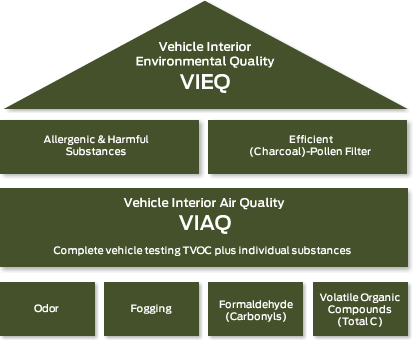Improving Vehicle Interior Environmental Quality and Choosing Allergy-Tested Materials
As part of our effort to deliver vehicles that are safe, green, smart and high quality, Ford is proactively addressing society’s growing concern about vehicle interior environmental quality, including air quality and allergens. Consistent with our ONE Ford global integration plan, a global cross-functional team at Ford focuses on selecting interior materials to reduce allergens and volatile organic compounds. This team is committed to investigating and developing comprehensive global approaches and strategies to address issues relating to vehicle interior air quality. The team has established global design guidelines for materials and filtration and is migrating those guidelines across Ford’s product lines.
Specifically, this team has been working since 2007 to develop a set of Vehicle Interior Air Quality (VIAQ) specifications that require the consideration of the air quality and allergen impacts of the materials and components in our vehicles. Under this standard, engineers test materials used on components with direct skin contact for allergy issues. The complete VIAQ standards include requirements for fogging, odor, aldehydes, substances of concern, total carbon at the component level, and air filtration. Many vehicles are also equipped with high-performance pollen filters to prevent allergenic pollens from entering the vehicle. Initially, the requirements were applied to European-based vehicles, and we are now phasing them into the U.S. We plan to implement them in our South American and Asia Pacific and Africa operations in the future.
The following graphic shows our overall approach to improving vehicle interior environmental quality, including our allergen and VIAQ specifications.

Looking ahead, we are researching ways to use in-vehicle communication systems to help drivers monitor and maintain their own health and wellness. We want to change the paradigm that in-car connectivity systems such as SYNC® can only be used for information and entertainment purposes. We recently introduced an Allergy Alert® app for Ford SYNC AppLink™ that allows drivers to check current and upcoming pollen and other health risk conditions with simple voice commands while keeping their hands on the wheel and eyes on the road. This app came out of research Ford began in 2012 to assess in-car health and wellness-connected services that could work with SYNC, such as medical device connectivity, cloud-based health management services and mobile app integration. As part of this research, we are also working with Microsoft, Healthrageous and BlueMetal Architects to develop additional systems that extend health management into the personal vehicle in a nonintrusive fashion.
We are also working on systems that can use Ford’s hands-free SYNC communication technology to capture biometric and vehicle data as the basis for real-time health and wellness advice and monitoring. For example, a driver could provide voice inputs, detailing important aspects of his or her health routine – such as the number of glasses of water consumed during the day, or what pills have been taken. Working with partner companies, the data received from the driver could be uploaded into the driver’s approved health data cloud and processed with other health data to create graphical reports the driver could access after having left the vehicle.
As part of our efforts to deliver healthy vehicle interiors, we are also researching microbial populations on vehicle interior surfaces with the goal of creating a cleaner, more aesthetically pleasing environment for our customers. Microscopic organisms, including mold and mildew, can spread over a variety of surfaces, leading to discoloration and even unpleasant odors. We worked with a team from the University of Michigan to evaluate the concentration and growth of microbes in vehicles. After identifying the hot-spot locations for microbial growth, we are now developing and testing part-coating formulations that could resist and potentially even reverse microbial growth, including silver-ion, ammonium salt and polyolefin wax with a nano-silver coating. Parts with the antimicrobial-treated coating are now undergoing real-world testing in a number of Ford development vehicles, and the coating is being evaluated for potential use in future Ford vehicle programs.










